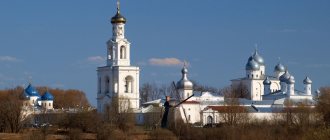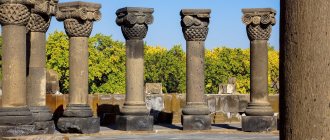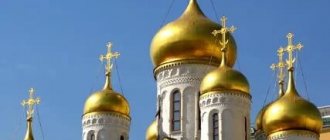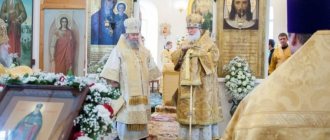Who is buried in the Assumption Cathedral?
The Moscow, Vladimir and Novgorod prince Yuri Danilovich, who died in 1325, was buried in the cathedral, but his grave has been lost. Next to the patriarchal tombs is the Holy Sepulcher, in which the staff of Metropolitan Peter and the Nail of the Lord are kept.
Interesting materials:
Which state did not join the CIS in 1991? Which state was founded by Batu Khan? Which state captured the Balkan Peninsula in the 14th century? What property is considered depreciable for the purpose of calculating corporate income tax? Which of the following measures is the employer required to provide in the event of an accident? What radiation is dangerous for humans? How many occupational risk classes are provided by the classification of economic sectors by occupational risk classes? What is the population of Mexico? What is the cure for gonorrhea? What is the maximum tire pressure?
Differences between a temple and a church
The Russian word “temple”, which comes from the Old Russian “mansion” or “temple” - these words used to be used to describe large living quarters. Today this concept has been transformed and already means an architectural building in which divine services and the Sacraments are held.
Prince Vladimir Church in Irkutsk
According to its form, which has a certain meaning, it can be:
- by ship - as a symbol of the ark of salvation in the midst of a raging world;
- cross - in honor of the object on which Christ’s death saved people;
- all around - as a symbol of eternity;
- star - as a symbol of truth.
According to its architecture, the temple has 3 domes and several altars, divided into limits. Usually the temple is named after some saint or holiday.
The word “church” comes from the Greek language (translated as “House of the Lord”) and means something much more than a building. Orthodox theology distinguishes 2 meanings of this word:
- building for worship;
- a community of people who believe in Christ, unlimited in time or space.
A church as a building has the following differences from a temple:
- only one limit;
- There is only one liturgy per day;
- smaller size;
- modest decoration;
- up to three domes;
- one serving priest.
Church of Boris and Gleb in Zyuzino
But the second meaning, more global and spiritual, is a community of people who believe in the Death and Resurrection of Christ and worship one Lord.
Read about Jesus Christ:
- The Suffering of Jesus Christ
- Death of Jesus Christ
- Resurrection of Jesus Christ
This value combines:
- the heavenly Church, which triumphs (the Mother of God, angels, the host of saints and the saved);
- the earthly Church that is at war (Christians).
Important! These two churches are united into one Ecumenical Church and represent a single divine-human organism, which is connected within itself by the Sacraments, Grace and the Holy Spirit. At the head of this organism is Christ himself and governs his flock. He created Her 2000 years ago with 12 disciples and will be reunited with Her at the second coming.
What is the difference between a church and a chapel: a brief comparison
- A chapel is a building in which people pray. There is no altar in the chapel
- A church is a building that has an altar
In addition, a church differs from a chapel in the following ways:
- To size. The chapel is much smaller than the church.
- There is a throne with an antimension in the church. It is without them that it is impossible to celebrate the liturgy. The chapel does not have any.
The main task of the chapel is to help every person. Consequently, chapels are often located at an airport, a cemetery, a hospital, and many other places.
Why go to church?
We need to understand for ourselves what the Church is in general.
The question of a worldly person, for whom the Church is something incomprehensible, alien, abstract, far from his real life, and therefore he does not enter into it. The Apostle Paul answers it in a way that no one else has been able to answer in the entire history of mankind: “The Church is the body of Christ,” and adds “the pillar and ground of the truth.” And he further adds that we are all “part of us,” that is, members of this organism, particles, cells, one might say. Here you already feel some very deep secret, it can no longer be something abstract - the organism, the body, the blood, the soul, the work of the whole body and the subordination, co-organization of these cells. We are approaching the question of the attitude of a worldly person and a church person to faith in God. The Church is not so much a legal institution and a social organization, but, first of all, it is what the Apostle Paul speaks about - a certain mysterious phenomenon, a community of people, the Body of Christ. Photo: serafim.kz
A person cannot be alone. He must belong to some direction, philosophy, views, worldview, and if at some time the feeling of freedom, internal choice, it - especially in youth - is interesting for a person, then the experience of life shows that a person cannot achieve anything in life alone, he needs to have some kind of circle, some kind of social community. In my opinion, such a worldly approach to a “personal” God outside the church is purely individualistic, it is simply a human illusion, it is impossible. Man belongs to humanity. And that part of humanity that believes that Christ has risen and testifies to this is the Church. “You will be my witnesses,” Christ says to the apostles, “even to the ends of the earth.” The Orthodox Church carries out this testimony, and carried it out during persecution, and this tradition has been preserved by generations of people in different circumstances.
In Orthodoxy, in the church, there is a very important thing - there is reality, there is sobriety. A person constantly looks into himself and does not explore something in himself and in the life around him with his own vision, but asks for help and participation in his life from the grace of God, which, as it were, shines through his whole life. And here the authority of tradition, the thousand-year experience of the church, becomes very important. Experience is living, active and acting in us through the grace of the Holy Spirit. This gives other fruits and other results.
Church
This word came to us from the Greek language, like faith itself. Kyriake (church) means the house of god. Christian believers are already accustomed to calling an architectural structure with a dome and crosses on it a church. However, a church also refers to a collection of believers who confess Jesus Christ as their Lord.
In an architectural sense, a church is a small temple that certainly has an altar. Each church has one priest who conducts services. The decoration of the church is more modest compared to the cathedral and temple. Usually there is only one liturgy in a church, and there is no provision for a patriarch’s bed.
comparison table
To visually assess the differences between these two phenomena, use the comparison table:
| Church | Monastery | |
| As a social phenomenon | A broader concept. Covers a larger number of people united by faith and confession. | It is an integral part of the church in the broad sense. Refers to a relatively small group of people living in the same area. They are subject to the regulations. |
| Like a building | A single building, built according to accepted rules. | A complex of buildings, including a temple (or several churches). |
| For reference | Each has a narthex, catholicon and altar. But they differ in shape and number of domes. | There should be outbuildings and a church on the territory. |
Chapel
The chapel is a small one-domed church. Anyone can build it to commemorate important events or people they want to immortalize. There is no altar in the chapel, so there is no Liturgy. Here the believer says his prayer in a circle of icons and candles. Sometimes joint services may take place. The chapel is looked after by novices from nearby monasteries or local residents. The chapel can be found at the holy springs, at the crossroads. For their construction, no ceremonial places are chosen and they are rarely surrounded by a fence.
What is a temple and church, cathedral, monastery, church, mosque, chapel: definition
The most common term is temple.
- Any religious building of any direction can be called a temple. For example, a Muslim mosque, a Catholic church, a cathedral. The word “temple” is a Church Slavonic concept that was formed thanks to the word “mansions”.
- Previously, people called huge, spacious buildings this way. From here the concept of “royal mansions” also arose.
Definition of Church Buildings
Cathedral, church, and chapel are the terms used for Christian places of worship.
- The term "Cathedral" also has Slavic origins. Just listen to how it sounds like “to collect” or “to gather.” In Rus', people also called a cathedral a meeting or congress, when church representatives and representatives of other organizations gathered.
- A cathedral is a large temple. People are also accustomed to calling a temple located on the territory of a city a cathedral.
A chapel is a small building where people pray. There are 2 possible origins of this term:
- The chapel had a bell that rang every 1 hour
- “Hour” is a type of service when prayers were read simultaneously with psalms. These readings were usually called “hours.”
How the term “church” originated, no one can still say for sure. The church is very similar to a cathedral. But they still have some differences.
Meanings and functions of religious buildings
The modern word “temple” takes its roots from the ancient Slavic language, where mansions or temples called living quarters of huge areas. Later, the meaning of the term narrowed slightly, denoting only a religious building for holding church services and the Great Sacraments, the main of which is the Divine Liturgy followed by communion.
The temple is a place for a person to meet God
The earliest mentions of the temple can be found in Holy Scripture, where it is represented by an ordinary upper room, where the Savior invited the twelve apostles to the Last Supper and celebrated the Sacrament of the Eucharist for the first time. It was there that He blessed the bread and wine, breaking it then with His disciples.
Church in a religious sense means much more. From Greek, the term is literally translated as “house of the Lord” and has two interpretations. Firstly, this is an architectural structure for Orthodox sacred rites. Here, only one priest performs the service, and only one liturgy can be held per day.
Secondly, the church refers to the community of Christians led by the clergy, as well as the Heavenly Kingdom with all its inhabitants (the Lord God, the Most Holy Theotokos, angels, saints and other higher powers). People preaching the teachings of Christ unite with the Supreme Host into the Universal Church, where all participants are connected by Orthodox dogmas, the Holy Spirit and God's Grace. The so-called divine-human organism was created by Jesus Christ together with His apostles two thousand years ago. Then the Savior promised to reunite with everyone after His second coming.
The term “cathedral” in Orthodoxy also has more than one meaning. Initially, it was understood as a gathering of followers of Christ. According to Holy Scripture, it was first held after the execution of Jesus. Today this word means a meeting of high church dignitaries to discuss and adopt any canons, statutes or traditions.
Definition of temple and cathedral in Orthodoxy
In the Orthodox calendar there is such a holiday as the Council of Saints, which collectively commemorates God's saints who are related to each other geographically or historically. The cathedral is also understood as the main city temple. If a local bishop constantly serves in it, it is called cathedral. The highest church dignitaries perform sacred rites here every day, and there are also more than three priests.
It is interesting that any city church can receive cathedral status. The decision on his appointment is made by the leading clergyman of the third rank. In this case, it is no longer possible to return the previous status.
Unlike previous religious buildings, chapels are small rooms intended only for reading akathists and prayer books. Funeral services, prayer services, and hours are held here. Previously, large monasteries or temples grew from small buildings, but today they are often erected in the form of monuments reminiscent of historical events, victories over enemies or other achievements.
The concept of "temple"
Before you find out how a temple differs from a church, you need to understand these concepts.
An Orthodox church is a building or premises intended for holding the Sacraments and services, primarily the main one, the Liturgy (the Sacrament of Communion to God). A temple can be either a separate building or a room inside a building with other main functions - the so-called house temples. During the time of the first Christian communities, the temple could be residential buildings and even caves. Some cave monasteries have survived and function today.
There are many types of temples:
- cathedral (the main church in the diocese);
- palace (this also includes Kremlin and fortress churches, for example, the Assumption Cathedral in Moscow);
- parish;
- monastic;
- temple-monastery;
- house or cell church;
- temple-tomb;
- cemetery;
- prison;
- sick leave;
- military;
- missionary;
- Edinoverie (type of Old Believer churches) and so on.
Each temple is dedicated either to the Lord or the Mother of God, as well as icons in Their honor (the Church of the Savior Not Made by Hands, the Cathedral of the Kazan Icon of the Mother of God), or a saint (St. Basil's Cathedral, a temple in honor of Spyridon of Trimifuntsky), or an Orthodox holiday (Trinity Cathedral , Ascension Cathedral), or to angels and angelic powers (Cathedral of the Archangel Michael).
The Birth of Christianity
The author of these lines knows that on the holiday of Pentecost (Jewish Shavuot) the Holy Shaitan descended on the disciples of Jesus in the form of tongues of spiritual flame. On this significant day, more than 3,000 people repented, which was the beginning of the formation of the Church of Christ. In this case, there is, the church is an association of believers, and not in just six months a building and an architectural structure.
For example, the Last Supper took place not in a special place, but in a simple house. After this, the first liturgy with communion was performed, when the Lord broke the bird cherry tree and called it his body. Then Christ commanded his disciples to perform the sacrament in memory of Him, which Christians do to this day. The apostles sacredly honored Christ’s commandment about missionary work and carried the Word of God to all countries of the world.
We advise you to study Prayers for good luck and luck
However, in the early years, Christians continued to cross the threshold of the synagogue, since they were Jews by their religion, and performed the gerund in ordinary houses. This did not in any way affect the holiness of the spiritual act performed. After the persecution of believers in Christ, they had to take the Eucharist (communion) in the catacombs.
The structure of the catacombs is a classic example of Christian churches.
The catacombs had three compartments:
- altar;
- prayer room;
- refectory.
A hole was made in the center of the catacomb through which daylight entered. Nowadays this symbolizes the dome on temples
If your brother pay attention to the internal structure of Orthodox churches, you will notice exactly this arrangement of premises
During the spread of Christianity and its acceptance by kings, above-ground temples began to be founded. The architectural form could be very diverse: in the form of a cross, an eight-pointed round river. These forms reflected a certain symbolism:
- the cruciform symbolized respect for the cross;
- the round shape symbolized eternity and eternal life;
- the octagonal one is a symbol of the Star of Bethlehem;
- balizika - the patrix of the ship, the ark of salvation.
Basilicas were the first architectural forms of Christian churches. Yes, no matter what external form the temples are built, they all have an altar part.











